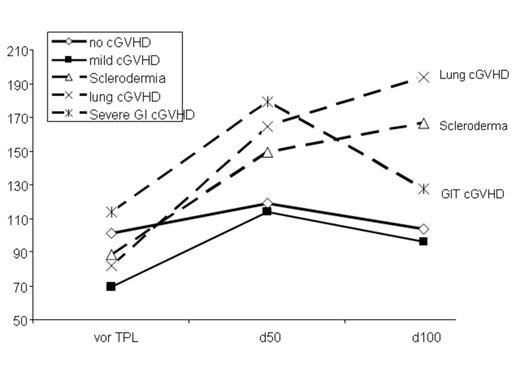Abstract
Introduction
Severe chronic graft versus host disease (cGvHD) is one of the main complications following allogeneic stem cell transplantation (SCT) and a major contributor to late treatment-related morbidity and mortality. The symptoms of the condition mimic autoimmune diseases like scleroderma, Sjögren syndrome, primary biliary cirrhosis, wasting syndrome or bronchiolitis obliterans.
The pathogenesis of GVHD is still poorly understood. However, increasing evidence suggests that endothelial injury and angiogenesis are involved. Chronic GvHD associates with a rarefaction of microvessels in the affected tissue. (Tichelli A. et al. 2008).We therefore hypothesized that VEGF serum levels could be used to predict occurrence of chronic GvHD.
Methods
Written informed consent to sample and data collection in accordance with the declaration of Helsinki was obtained from 394 patients undergoing SCT between 2002-2011 at our institution. Blood serum samples were obtained on day 0, day 50 and day 100 following transplantation. Concentrations of VEGF were quantified in patient sera by the multiplex protein array technology (Luminex) according to the manufacturer's instructions for protein multiplexing (Bio-Rad).
The occurrence of mild and severe cGvHD was evaluated retrospectively by chart review using the NIH Consensus criteria in chronic Graft versus Host Disease (Filipovic et al., 2005). A score of 3 in the clinical scoring of organ systems suggested in the consensus criteria was considered severe cGvHD. In cGvHD of the lung a score of 2 and higher was considered severe. Isolated elevations of bilirubin or liver enzymes were only considered cGvHD if confirmed by histopathology. Time to onset of mild and/or severe cGvHD and organ systems involved were recorded. All statistical calculations were performed using SPSS19. The rates of mild and severe cGvHD were plotted using cumulative incidence analysis of cause-specific hazards and compared in various groups using log rank test.
Results
The median age of patients was 52 years (17 - 70). 242 patients (61%) were male and 152 (39%) were female. Patients were suffering from a broad range of underlying diseases (SAA 5, ALL 42, AML 119, Amyloidosis 1, CLL 29, other B-NHL 52, T-NHL 12, CML 15, other MPS 19, MDS 32, HD 5, MM 61, sarcoma 2). 148 (38%) patients had a matched family donor (MFD), 156 (40%) had a matched unrelated donor (MUD), 90 (23%) had a mismatched unrelated donor (MMUD). 308 (78%) patients received myeloablative conditioning (MAC), 86 (22%) received reduced intensity conditioning (RIC). 281 (71%) patients received ATG, 113 (29%) did not receive ATG. 166 patients (42%) developed mild cGvHD and 75 (19%) developed severe cGvHD. 24 (6%) patients developed sclerodermatous changes or fasciitis, 17 (4%) developed severe lung cGvHD and 26 (7%) developed severe gastrointestinal GvHD. The median time of onset of severe cGvHD was 11.18 months (1.4- 88.9).
Median serum concentrations of VEGF on days +50 and +100 in those patients developing severe cGvHD were markedly elevated as compared to those patients developing no or only mild cGvHD: i) d+50: no cGvHD 119.5 (4.3-1577.5) pg/ml, mild cGvHD 113,8 (9.1-620.7) pg/ml, severe cGvHD 158.11 (22.5-415.3) pg/ml; p=0.044). ii) d+100: no cGvHD 107.8 (7.8-753.3) pg/l, mild cGvHD 95.4 (15.5-561.9) pg/ml, severe cGvHD 158.1 (20.2-607.2) pg/ml, p=0.048). Moreover, VEGF levels on days +50 and +100 in those patients developing severe lung GvHD, sclerodermatous lesions or severe gastrointestinal GvHD were found to be elevated (Figure 1 ). High serum concentrations of VEGF did not correlate with acute GvHD of any grade or steroid refractory acute GvHD. Serum concentrations of VEGF >150 pg/ml on day +100 after allogeneic stem cell transplantation were associated with a 2.1 fold higher rate of severe cGvHD (p=0.001).
Conclusions
These results suggest that VEGF serum levels on day +50 and day +100 after allogeneic stem cell transplantation may be useful for early prediction of severe cGvHD. One explanation for prognostic VEGF elevations occurring long before onset of clinical cGVHD could be that endothelial cell alterations are involved in the pathogenesis of severe cGvHD which develop early but become only relevant after tapering immunosuppression
No relevant conflicts of interest to declare.
Author notes
Asterisk with author names denotes non-ASH members.


This feature is available to Subscribers Only
Sign In or Create an Account Close Modal